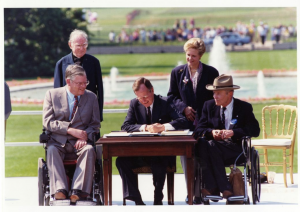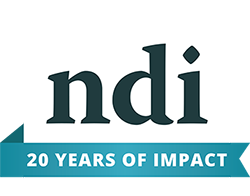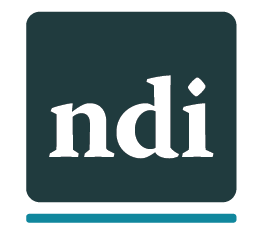This year commemorates the 30th annivers ary of the Americans with Disabilities Act (ADA). While many would agree that much progress has been made since President H.W. Bush signed the legislation into law, significant work remains until people with disabilities are fully included in employment, their communities and in the economic mainstream.
ary of the Americans with Disabilities Act (ADA). While many would agree that much progress has been made since President H.W. Bush signed the legislation into law, significant work remains until people with disabilities are fully included in employment, their communities and in the economic mainstream.
We sat down with Michael Morris, Founder and Senior Strategic Advisor at National Disability Institute (NDI) and Kathy Martinez, Senior Vice President, Head of Disability and Accessibility Strategy, Enterprise Marketing, Wells Fargo to discuss the impact of the ADA in the last 30 years and what the future holds.
Where were you on the day the Americans with Disabilities Act was signed?
MM: I was at the White House. It was a beautiful blue sky day. There were so many people on the White House lawn. There was a sense of excitement and pride. It was a very emotional moment when President Bush signed the document and said, “Together, we must remove the physical barriers we have created and the social barriers that we have accepted. For ours will never be a truly prosperous nation until all within it prosper.”
KM: I was at the Center for Independent Living in Berkeley, California celebrating the signing of this groundbreaking legislation.
How did you feel on that day?
MM: I was excited. I had come to Washington nine years before as the first Kennedy Foundation public policy fellow and had worked with Senator Lowell Weicker from Connecticut, who had helped conceptualize an early version of the ADA with the National Council on Disability before it was introduced in Congress. It seemed so impossible a challenge to unite the diverse disability community behind a comprehensive civil rights bill and build bipartisan support. I am not sure I realized the real hard work was still ahead of us. Attitudes and behavior change slowly.
KM: I felt happy and hopeful and was excited to know that we were a part of the civil rights train and was curious to see how things would play out.
After the ADA began to be implemented, what changes did you see first?
MM: The first changes were changes in the physical built environment. Step entrances to restaurants, banks and every type of store were replaced by ramps and changes in design. Like all major civil rights laws, court cases helped further interpret protections against discrimination in the workplace, access to public services and with the Supreme Court decision in Olmstead began a series of legal precedents to end segregation and isolation of individuals with disabilities with the expanded interpretation of the ADA to support community participation and inclusion.
KM: First I noticed a lot of resistance, but then both the public and private sector began to discuss how they might weave accessibility in to their products and services. I noticed easy fixes first—like braille signage on elevators and hotel room doors.
Which changes have had the biggest impact on your life and why?
MM: The biggest impact on my life was the observation of the changes that have been the slowest to occur. The promise of the ADA was to end discrimination, but also to “advance economic self-sufficiency.” Thirty years later, adults with disabilities are two times more likely to be living in poverty than their nondisabled peers, more likely not in the labor force and restrained from building savings and assets by their dependence on healthcare, social security and other means-tested benefits that require an individual with a disability to stay poor to be eligible for these benefits. Fifteen years ago, I helped start National Disability Institute to put more public attention on the economic struggles of people with disabilities and help promote pathways to greater economic stability and security. True community inclusion and participation is not possible without collaborative efforts of the policy, financial and business communities to create economic opportunity for all with jobs, affordable housing and healthcare and accessible financial products and services to meet the needs of LMI people with disabilities. The biggest impact still to come is to focus on solutions to these economic challenges.
KM: The changes which have impacted me most have been the ability to receive and share information in a timely manner. As a blind person, I depend on the following: announcements of stops on public transportation; movies/TV shows with video description; accessible ATMs and bank products/information and accessible print and online media.
What changes haven’t occurred yet, but that you would like to see happen?
MM: With the new final rule for the Community Reinvestment Act (CRA) issued by OCC on June 5th, we have, for the first time, a federal regulator putting a spotlight on banks to respond to the economic challenges facing people with disabilities. With investment, lending and services, OCC-regulated banks can support workforce and housing development activities, lending to improve access to assistive technology and expanded availability of financial education and counseling for people with disabilities.
KM: I would like to see physical and digital accessibility become standard operating practice and not an afterthought for both public and private companies. Next, I would like to see more people with disabilities employed as a matter of course, which would improve expectations, opportunity and public attitude toward our community at large.
How has society changed in the way it views or treats people with disabilities?
MM: The greatest changes are quantifiable and others are more qualitative. Before COVID-19, a record number of individuals with disabilities have gone on to higher education and are a part of inclusive workforces across market sectors. But more than numbers, public attitudes toward people with disabilities continue to change. Society is more accepting and inclusive. People with disabilities are valued as productive, talented members of the workforce in small and large companies.
KM: As we are seen as contributing members of our communities, attitudes are slowly changing. As accessibility becomes a matter of course, more people have been able to function independently and participate in society.
Is economic self-sufficiency a realized promise of the ADA? Why or why not?
MM: The next 30 years of ADA implementation must focus on building and supporting pathways to economic stability and security. People with disabilities must be encouraged to set financial goals and be supported to reach them. People with disabilities must be encouraged to be savers, investors, asset builders, homeowners and entrepreneurs that are contributors to our nation’s economy.
KM: Not yet—we have a long way to go before the disability community sees economic self-sufficiency. This is largely because accessibility is still viewed as an afterthought or a “nice thing to do,” when in fact we know that universal design benefits everyone and also allows people with disabilities to work, therefore benefitting our economy.
What does financial inclusion mean to you?
MM: Financial inclusion means that financial products and services are responsive to the needs of people with disabilities at all stages of the life cycle: students, workers, homeowners, investors, parents with children and retirees. Almost 50 percent of people with disabilities are unbanked or underbanked. That statistic must change.
KM: Financial inclusion means that I am able to bring the skills and abilities I have to the workplace and am able to compete, advance and succeed.
What can be done so that people with disabilities are financially included in this country?
MM: Several things could be done. First, businesses across market sectors need to increase their hiring, retention and opportunities for career advancement for people with disabilities in diverse jobs across market sectors. Second, federally regulated banks need to increase their CRA activities (investing, lending and service) to advance economic opportunity and financial stability for people with disabilities. There is need for CRA activities to support more affordable and accessible housing development, small business lending to advance opportunity for entrepreneurs with disabilities and increased collaboration with disability-related community nonprofit groups to expand the availability of financial counseling and education for informed financial decision making.
KM: Many of our disability-related laws are outdated and penalize a person with a disability who wants to work. Perhaps making it easier to go from benefits to some level of employment without making it so difficult. Our benefits policies are sadly outdated; benefit programs such as SSI were designed with a belief or framework that people with disabilities could not work, be self-sufficient or financially independent. It seems those programs need to be fundamentally revised to reflect the current view and reality.
What improvements have banks made to serve their customers with disabilities better?
MM: Most banks today have a group of staff exclusively focused on improving the accessibility of products and services. Many banks go beyond ADA compliance to improve the customer experience for individuals with disabilities, both with in-person banking and online. Particular efforts have been made to make information about financial products and actual delivery of services to be accessible for people who are blind, deaf or hard of hearing and other types of disabilities.
KM: Over the years, banks have made their products and services more accessible starting with ATMs and moving to providing information in alternate formats and accessible online applications. In addition, banks are seeing the value and perspective people with disabilities bring to their workforce.
Thirty years later, what work remains undone to fulfill the promise of the ADA?
MM: The laser focus for the future must be on fulfilling the ADA promise to “advance economic self-sufficiency” for people with disabilities. The focus must be not only on more opportunity in diverse, inclusive workplaces, but also access to capital to improve small business startup and growth for individuals with disabilities and lending that allows asset building through purchase of individual homes. The advancing economic self-sufficiency promise of the ADA will only be achieved when financial institutions, government, businesses and community nonprofit groups work together to increase participation of Americans with disabilities in higher education, inclusive apprenticeships as a pathway to careers and investment options to build assets long term that improve financial health and well-being.
KM: Weaving accessibility and disability awareness into standard operating practices of products, services and information both in the public and private sector.
What new frontiers remain for people with disabilities?
MM: People with disabilities need to be valued as contributors to the growth of the economy at a community and national level. As significant improvements have been made in the protection of the civil rights of people with disabilities, the next frontier must focus on economic advancement and improved financial health for people with disabilities. Forty years ago, Congress passed the Community Reinvestment Act to create critical responsibilities of our nation’s regulated financial institutions to invest in low and moderate income (LMI) neighborhoods and the people who live there. No group remains more economically vulnerable as part of the low- and moderate-income community than people with disabilities who are also challenged by the identities of race and/or ethnicity and gender. Over one in three individuals who are disabled and a member of a racial or ethnic minority have lost their jobs as a result of the COVID-19 pandemic. As our nation fights its way back in a post-COVID-19 recovery, individuals with disabilities, also challenged by the intersection of race and/or ethnicity and gender, must be the target for CRA investment, lending and service activities. Last year, federally regulated banks spent more than $400 billion meeting CRA obligations. If each year, over the next 10 years, these same banks expended one percent or roughly $4 billion annually to respond to the economic challenges of LMI individuals with disabilities, new opportunities and pathways would be established and expanded to advance their economic stability and security. Whether it be workforce or small business development, or expanded access to technology, affordable housing or improved educational opportunity, the next frontier builds on the foundation of full citizenship established by the ADA to new expectations and outcomes of economic inclusion and stability.
KM: My first thought on this is that there’s some evidence, albeit slim, that people with disabilities are not only receiving accommodations to allow them to work, but are also finding situations where their unique abilities are leveraged to add value. For example, some people with autism are extraordinarily skilled at work that requires high level analytical skills and attention to detail, making them not only a good fit for some work, but a superior fit.
Michael Morris is the founder of National Disability Institute (NDI) and a Senior Strategic Advisor. He has more than 30 years of experience in and outside of government pioneering new strategies to improve the lives of people with disabilities. Morris serves as an advisor and technical expert to multiple federal agencies on policy and systems relationships at federal, state and local levels to advance economic stability, mobility and asset development for persons with disabilities.
In 1981, he was named the first Joseph P. Kennedy Fellow in Public Policy and came to Washington, D.C. to work in the Office of Connecticut Senator Lowell Weicker, as legal counsel to the United States Senate Subcommittee on the Handicapped. Morris also served subsequently as counsel to the U.S. Senate Small Business Committee. From Capitol Hill, he went to work at United Cerebral Palsy Association as the first director of government relations, then as director of community services and finally as national executive director. During his 14-year tenure, his leadership put a focus on needed assistive technology and its essential role in accommodating people with disabilities in the areas of employment, education, communications and daily living. In 2001, Morris helped establish NDI to advance the social and economic independence of persons with disabilities through strategic investment and technical assistance activities nationwide that bring together government, corporations, foundations and community and faith-based organizations.
Morris received his undergraduate degree with honors in Political Science from Case Western University in Cleveland, Ohio and his law degree from Emory University School of Law in Atlanta, Ga.
Kathy Martinez is Senior Vice President Head of Disability and Accessibility Strategy, Enterprise Marketing, Wells Fargo where she works to expand the company’s capabilities and programs dedicated to serving customers with disabilities and their families.
Martinez is the former assistant secretary of the Office of Disability Employment Policy (ODEP) for the U.S. Department of Labor. She led ODEP in putting policy priorities into practice through several innovative grant programs. These include Add Us In, through which a nationwide consortia worked to increase the capacity of small businesses to employ people with disabilities. The grant program also included the Employment First State Leadership Mentor Program, through which several states received support to promote community-based, integrated employment as the primary outcome for people with significant disabilities.
A graduate of San Francisco State University, Martinez speaks and publishes on a wide array of topics related to disability employment, including the emergence of disability as an essential component of workplace diversity and inclusion and the importance of expectation in ensuring youth with disabilities grow up with an assumption of work—a topic on which Martinez, who herself was born blind, offers compelling and personal perspective.



